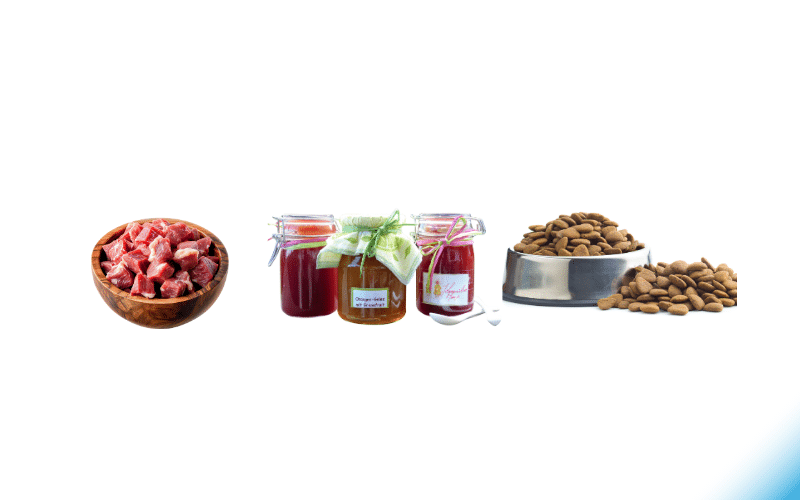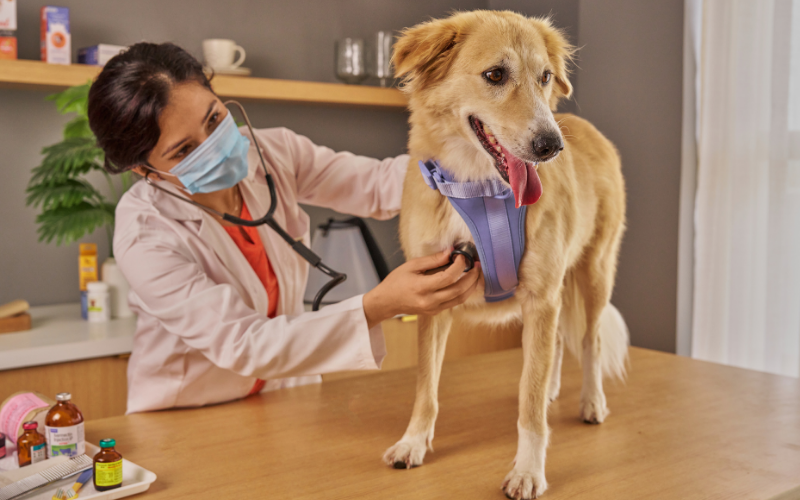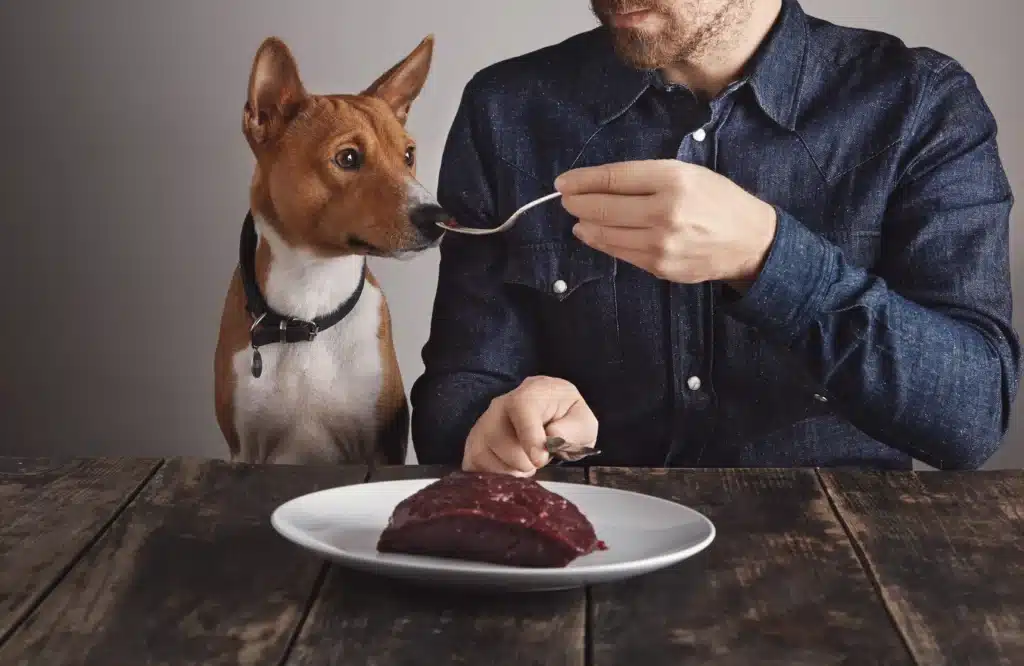Choosing the right dog food improves canine health, prevents obesity, and extends lifespan. Your dog’s food is more than just a meal — it’s the single biggest factor that determines how long and how well they live.A study conducted by Texas A&M University Dog Aging Project (2025) involved more than 50,000 dogs and revealed that half of them are overweight, putting them at a higher risk of developing arthritis, diabetes, and skin disease. According to Cornell Universit, Riney Canine Health Center (2023), 60% of dogs were overweight and obese, which confirms that the most frequent diagnosis is obesity, more common than either skin or gastrointestinal health issues.
2. What Are the Effects of Poor Nutrition on Dogs?
There are four measurable health outcomes of poor nutrition.
Obesity: Increases the incidence of arthritis and diabetes, decreases life span
Skin Disorders: Omega-3 and Omega-6 deficiency lead to dermatitis and alopecia.
Low Energy: Low energy and protein deficit reduce muscle mass and endurance.
Weakness of the Immune System: Vitamin and mineral deficiency increases infection rates.
A high-protein, high-fiber diet lowers the inflammatory markers in overweight dogs by 15% in 24 weeks, according to the University of Illinois (2024), which demonstrates that diet changes health outcomes.

3. What Will This Guide Teach You?
This resource outlines four main areas of informed food choice.
- Label Reading: Order of ingredients, guaranteed analysis, AAFCO adequacy statement.
- Nutrient Science: Vitamins, minerals, fats, proteins, carbs, each by life stage.
- Categories of Food: Kibble, wet, raw, freeze-dried, and homemade, with evidence-based benefits/disadvantages.
- Health Tracking: Body condition rating, allergy check, and schedule of portion control.
Feeding by Life Stage
The nutrient requirement of dogs varies with growth. Food by life stage aids in avoiding under- and over-nutrition.
Tip: Large breed puppies require moderate amounts of calcium to prevent orthopedic problems – find Large Breed Puppy labels.
| Life Stage | Life Stage | When to Switch |
|---|---|---|
| Puppy | High protein (≥ 22.5%), fat (≥ 8.5%), calcium & phosphorus for bone growth | Switch when growth plates close (Small: 10–12 mo · Large: 12–18 mo · Giant: 18–24 mo) |
| Adult | Balanced protein (≥ 18%), moderate calories to prevent obesity | After the puppy stage is complete |
| Senior | Regulate calories to avoid weight gain, add additional omega-3s, and provide joint support. | ~7+ years (depends on breed size) |

Store-Bought vs. Homemade Dog Food
The first big decision that most pet owners have to make is choosing between commercial and homemade food.
Commercial (Store-Bought) Food.
- Balanced Nutrition: Dependable brands would be guided by the AAFCO to provide full and balanced diets.
- Easy: This product needs no cooking or nutrient monitoring, so it can be measured and put on the table.
- Inexpensive: Bulk kibble is the cheapest per calorie.
- Quality Varies: Always look at the ingredient list and adequacy statement.
Homemade Diets
- Complete Control: You are well-informed about everything your dog is consuming.
- Customization: Customizable regarding allergies or sensitivities.
- Laborious: Cooking, measuring, and balancing nutrients.
- Possibility of Imbalance: A majority of online recipes are not complete. Always seek advice from a veterinary nutritionist or rely on reputable sites (e.g., BalanceIt.com) to be safe.
Raw Diet Warning:
Research indicates 75% of raw diets include pathogenic bacteria such as Salmonella or E. coli. This is a health hazard to dogs as well as human beings. In case of raw, observe clear hygiene and consult your veterinarian.
Dog Nutrition Basics
What are the basic nutrient requirements for dogs?
Dogs need six key classes of nutrients, which include proteins, fats, carbohydrates, vitamins, minerals, and water.
AAFCO identifies two stages of nutrient adequacy, which include Growth and Reproduction and Adult Maintenance.
What minimum protein and fat levels does AAFCO require?
AAFCO specifies exact minimum percentages on a dry-matter basis:
- Growth & Reproduction: ≥ 22.5% crude protein, ≥ 8.5% crude fat.
- Adult Maintenance: ≥ 18.0% crude protein, ≥ 5.5% crude fat.
What essential vitamins and minerals must dog food include?
Essential vitamins and minerals include:
Calcium, phosphorus, potassium, sodium, chloride, magnesium, iron, copper, manganese, zinc, iodine, selenium, and vitamins A, D, E, K, and B-complex.
AAFCO lists precise minimum mg/kg for each in Growth & Reproduction and Adult Maintenance.
What are the required amino acids in dog diets?
AAFCO mandates minimum percentages of essential amino acids:
- Arginine ≥ 1.0% (Growth & Reproduction)
- Lysine ≥ 0.90% (Growth & Reproduction)
- Methionine ≥ 0.35% (Growth & Reproduction)
Values differ slightly for Adult Maintenance but remain listed in AAFCO nutrient profiles.
Why is water intake essential?
Water plays an important role in digestion, temperature regulation, and waste elimination.
Clinical studies indicate that ≥ 5% water loss makes the body dry up, producing dehydration symptoms such as skin tenting and gum drying. Any loss of more than 10 percent may be fatal unless promptly remedied.
3. Decision-Making Tips
- Select the food within your budget and availability.
- Take into account the sense of flavor and texture – palatability is a factor to consider.
- When it comes to keeping food fresh, buy bag sizes that you can utilize in 4- 6 weeks.
Types of Dog Food and Their Pros and Cons

3. What are the main types of dog food and their pros and cons?
Dog food is available in five major types, namely dry (kibble), wet (canned), raw/RMBD, freeze-dried/dehydrated, and homemade. They differ in terms of moisture content, nutrient consistency, risk of contamination, and price.
What defines dry (kibble) food?
Kibble food is composed of moisture (approximately 6-10%) and processed using extrusion.
| Pros | Cons |
|---|---|
| High shelf life and storage. | Fat content may be ≤ 90% of the declared value, risking an energy deficit |
| Cheapest per calorie | Less palatability among picky eaters. |
| Helps to maintain dental health through chewing. |
What defines wet (canned) food?
Wet food has a moisture of approximately 75-78% and is canned.
| Pros | Cons |
|---|---|
| Improves hydration | Refrigeration is necessary after opening. |
| More palatable for most dogs | More expensive than kibble to eat. |
| Healthy for dogs with dental problems. | Reduced shelf life on opening. |
What defines raw / RMBD (Raw Meat-Based Diets)?
RMBDs are raw meat, internal organs, and bones, which are served fresh or frozen.
| Pros | Cons |
|---|---|
| The owners report that the coat and stool are much better. | Refrigeration is necessary after opening. |
| Protein is high, which helps to maintain muscle. | 33-45% surpass fat or protein deviations. |
| Fat level is 33-95 g/Mcal, which is a danger to some dogs developing pancreatitis. | |
| Needs high hygiene and storage. |
What defines freeze-dried or dehydrated food?
Freeze-dried foods are nutritious since the moisture is removed in a vacuum.
| Pros | Cons |
|---|---|
| High protein digestibility | Expensive per calorie |
| Safer storage than raw | Has to be rehydrated prior to feeding. |
| Portable and light in weight. |
What defines homemade diets?
Homemade diets are self-cooked or raw, with either cooked or raw ingredients.
| Pros | Cons |
| Complete ingredient control. | Frequently unbalanced without vet formulation. |
| Avoids additives and preservatives. | Usual deficiency of calcium, phosphorus, vitamins A and D. |
How to Read Dog Food Labels
What items does AAFCO require on all pet food labels?
AAFCO requires eight main label items:

- Product & brand name
- Intended species (dog vs cat)
- Net quantity statement (weight/volume)
- Guaranteed analysis
- Ingredient statement
- Nutritional adequacy statement
- Feeding directions (if “complete & balanced”)
- Manufacturer name & address
What is the Guaranteed Analysis?
Guaranteed analysis lists nutrient minimums and maximums.
- Minimum crude protein & crude fat.
- Maximum crude fiber & moisture.
- Additional nutrients must be guaranteed if label claims include them
How must the Ingredient Statement be presented?
Guaranteed analysis contains nutrition minimums and maximums.
- Minimum crude protein, crude fat.
- Maximum water and fiber.
- Other nutrients should be ensured to be provided, as they have been declared on the label.
What does the Nutritional Adequacy Statement tell you?
- It shows whether the food is complete and balanced at a stage of life.
- Product will be required to specify life stage: Growth and Reproduction, Adult Maintenance, or All Life Stages.
- Forms of statement are: “Formulated to meet, Animal feeding tests, or Provides nutrition comparable to for defined profiles.
What are Feeding Directions, and why are they important?
Feeding guidelines are based on the amount of food to feed.
- Should weigh the dog and the portion amount.
- Adjusted to age level and normal body status.
- Helps prevent obesity and overfeeding.
Health Monitoring and Common Mistakes to Avoid

How do you monitor a dog’s body condition?
Veterinarians use a 9-point Body Condition Score (BCS) system.
Ideal dogs score 4–5/9: ribs palpable with slight fat cover, visible waist from above, abdominal tuck from side. Dogs scoring ≥ 7/9 are clinically obese. (wsava.org)
How often should a dog’s weight be checked?
Adult dogs should be weighed every 1–3 months.
More frequent weighing is recommended for puppies, senior dogs, and dogs with weight-related diseases. Frequent checks help detect trends early and adjust portions. (avma.org)
What feeding mistakes increase obesity risk?
Three common errors contribute to obesity prevalence:
- Free-feeding or leaving food out all day
- Ignoring label portion directions and calorie needs
- Feeding excessive treats (should be ≤ 10% of daily calories)
AVMA states obesity shortens lifespan by up to 2.5 years in dogs.
What transition schedule prevents digestive upset?
Switch food gradually over 7 days:
- Day 1–2: 75% old, 25% new
- Day 3–4: 50% old, 50% new
- Day 5–6: 25% old, 75% new
- Day 7: 100% new
Gradual transition reduces diarrhea and vomiting. (vcahospitals.com)
What symptoms require veterinary consultation?
Six symptoms need prompt vet evaluation: vomiting, chronic diarrhea, lethargy, sudden weight change, persistent skin irritation, and refusal to eat.
These may signal food allergies, malabsorption, or metabolic disease.
Post-Transition Health Checklist
After switching foods (gradually over 7 days), monitor your dog for 4 weeks:
- Appetite: Eager to eat meals.
- Coat Quality: Shiny, not excessively shedding.
- Stool: Firm, no chronic diarrhea or constipation.
- Weight: Maintain a Body Condition Score (BCS) of 4–5/9.
- Energy: Normal activity levels, playful and alert.
If any issues appear, adjust portion size or consult your vet.
Conclusion and Key Takeaways
What is the key takeaway for choosing the right dog food?
Choosing the right dog food improves health, maintains ideal weight, and can extend lifespan by up to 2.5 years.
Peer-reviewed studies confirm 50–60% of U.S. dogs are overweight, and diet quality directly influences longevity, immune strength, and disease risk.
What steps ensure the best diet for your dog?
- Read labels carefully: Choose foods meeting AAFCO nutrient profiles.
- Prioritize whole proteins: Chicken, beef, fish listed first.
- Match life stage: Puppy, adult, senior, or all-life-stages formulas.
- Measure portions: Follow feeding directions and adjust for activity.
- Monitor weight: Keep BCS at 4–5/9 for optimal health.
What is the final call to action for pet owners?
Start by checking your current dog food label today. Compare protein %, fat %, and adequacy statement with AAFCO standards. Make gradual adjustments over 7 days if you switch foods, and consult your veterinarian for any health concerns.
References
- Texas A&M University, Dog Aging Project. (2025). Annual Study Findings. Retrieved from https://dogagingproject.org
- Cornell University, Riney Canine Health Center. (2023). State of Canine Health Report. Retrieved from https://www.vet.cornell.edu/hospitals/riney-canine-health-center
- University of Illinois Urbana-Champaign, Department of Animal Sciences. (2022). Weight loss and high-protein, high-fiber diet consumption impact blood metabolite profiles, body composition, voluntary physical activity, fecal microbiota, and fecal metabolites of adult dogs. Retrieved from https://aces.illinois.edu/news/overweight-dogs-respond-well-high-protein-high-fiber-diet
Frequently Asked Questions About Choosing Dog Food
Q1. Is grain-free dog food healthier?
Grain-free food is not automatically healthier.
FDA studies (2018–2023) investigated grain-free diets for links to canine dilated cardiomyopathy (DCM). Results showed some dogs improved heart function after switching back to grain-inclusive diets. (fda.gov)
Q2. What is the best protein source for dogs?
Named animal proteins are of the highest quality.
AAFCO and WSAVA recommend complete proteins such as chicken, beef, fish, or lamb. Proteins must meet essential amino acid requirements — e.g., lysine ≥ 0.90%, methionine ≥ 0.35% (growth & reproduction). (aafcoorg)
Q3. How many calories does an average dog need per day?
Adult dogs need ~95–110 kcal per kg of body weight per day.
MER (maintenance energy requirement) formula:
1. Resting Energy Requirement = 70 × (Body Weight in kg^0.75)
2. Multiply by activity factor (1.2–1.8) for total calories. (merckvetmanual.com)
Q4. How often should dog food be changed?
Dog food should be changed only when medically necessary or for a life stage.
Transitions must be gradual over 7 days: 75/25 mix first 2 days, 50/50 next 2 days, 25/75 final 2 days, then 100% new food on day 7. (vcahospitals.com)
Q5. Are by-products bad for dogs?
Named meat by-products are safe and nutritious.
AAFCO defines by-products as organ meats like liver, kidneys, lungs — rich in vitamins and minerals. The risk arises with unnamed or generic “animal by-products” where the source species is unclear.


